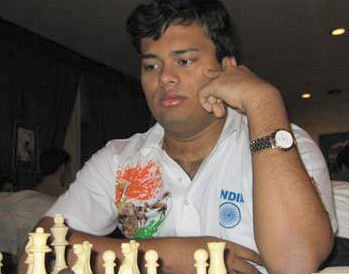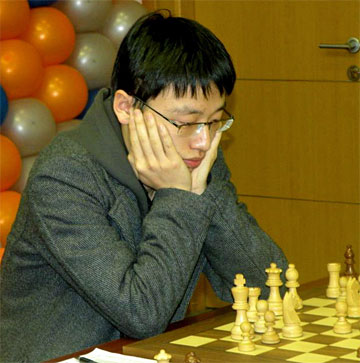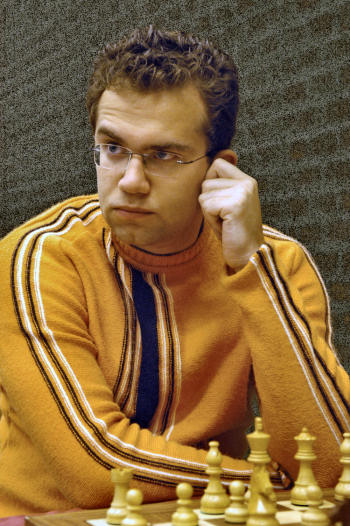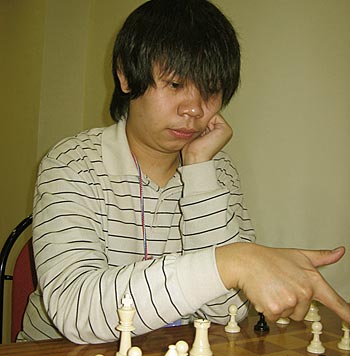| Latest | Greatest | Lobby | Journals | Search | Options | Help | Login |
|
|
|
This topic is archived. |
| Home » Discuss » Topic Forums » Sports |
|
| Jack Rabbit
|
Sun May-24-09 03:51 PM Original message |
| The JR Chess Report (May 24): Shrov wins Sofia; Ganguly, Zhou take Subic Bay |
|
Shirov Defeats Magnus in Final Round to Win MTel Masters
 Veteran grandmaster Alexei Shirov of Spain by way of Latvia defeated 18-year-old Norwegian Magnus Carlsen in a dramatic final-round showdown to win the fifth annual MTel Masters in the Bulgarian capital of Sofia yesterday. Magnus began the day alone in first place with 6 points, a half point over Shirov and former FIDE world champion Veselin Topalov. He needed only a draw to assure himself at least a share of first place while Shirov needed a win to leap over Magnus in the standings. Shirov, playing White against Magnus, opened with his King's pawn. Magnus responded with a Sicilian Game which spun into the sharp Sveshnikov Defense. Shirov won in thirty moves. Meanwhile, Topalov drew his game against Chinese grandmaster Wang Yue to finish tied for second place with Magnus. Shirov is a popular grandmaster amonng chess fans known for his aggressive and risky style. As a youth in the Latvian capital of Riga, he studied chess under the master swashbuckler himself, former world champion Mikhail Tal. Ganguly, Zhou Weiqi, Zhang Xiaowen Win Asian Championships  Ganguly and Zhou take general competition Grandmasters Surya Shekhar Ganguly of India and Zhou Weiqi of China tied for first place Saturday with 8 points apiece in the general competition of the 11-round eighth annual Asian Continental Championships held in Subic Bay, the Philippines. Ganguly was awarded official top honors by virtue of his superior tie break scores. Six players tied for third place with 7� points each, including young grandmaster Le Quanng Liem of Vietnam, the unheralded veteran Filipino GM Rogelio Antonio and fifteen-year-old GM Hou Yifan of China, one of only two ladies competing in the general tournament. Zhang Xiaowen wins Asian women's championship Zhang Xiaowen of China, a mere WIM, won the women's competition of the Asian Continental Championships Saturday with 9 points in 11 rounds in Subic Bay. WGM Huang Qian of China was second with 8 points and Chinese MFM Ding Yixin and WGM Subbaraman Meenakshi if India tied for third with 7� points each. Chicago Open Is Held over Memorial Day Weekend  The 18th annual Chicago Open is being held over Memorial Day weekend in Wheeling, Illinois. The seven-round tournament began Friday evening with a single round two rounds played yesterday and two rounds each on tap today and tomorrow. After three rounds, GM Darman Sadvakasov of Kazakhstan, the winner of this year's Foxwoods Open, is alone in first place with a perfect score. Calendar Sigeman Co Chess Tournament, Malm� 3-7 June. Aerosvit International Tournament, Foros (Ukraine) 9-20 June. World Open, Philadelphia 29 June-5 July. Sparkassen Chess Meeting, Dortmund 2-12 July. San Sebastian International Tournament 6-16 July. Former world champion Karpov is among the participants; US Champ Nakamura will also compete. Canadian Open, Edmonton 11-19 July. Czech Open, Pardubice 16 July-2 August. Biel Chess Festival 19-30 July. This year's GM Tournament is a Category 19 that includes Morozevich, Ivanchuk, Gelfand, Alekseev, Vachier Lagrave and Caruana. Pan-American Continental Championship, S�o Paulo 25 July-2 August. Mainz Chess Classic 27 July-2 August. US Open, Indianapolis 1-9 August. FIDE Grand Prix, Yerevan 8-24 August. Howard Staunton Memorial, London 8-17 August. Played at historic Simpson's Divan. World Junior Championship, Mar del Plata (Argentina) 16-29 October. World Cup, Khanty Mansiysk 28 November-15 December. London Chess Classic 7-16 December. |
| Printer Friendly | Permalink | | Top |
| Jack Rabbit
|
Sun May-24-09 03:52 PM Response to Original message |
| 1. This Week's Games |
|
Your humble hare acknowledges the assistance of Fritz 6.0 on analysis. Diagrams on the Jack Rabbit Chess Report are made with Chess M�rida, a true type font that can be downlaoded free here. !""""""""# $tMvWlVmT% $OoOoOoOo% $ + + + +% $+ + + + % $ + + + +% $+ + + + % $pPpPpPpP% $RnBqKbNr% /(((((((() WHITE White to move (This position is a theoretical draw) |
| Printer Friendly | Permalink | | Top |
| Jack Rabbit
|
Sun May-24-09 03:54 PM Response to Reply #1 |
| 2. MTel Masters, Sofia |
|
Edited on Sun May-24-09 04:14 PM by Jack Rabbit
|
| Printer Friendly | Permalink | | Top |
| Jack Rabbit
|
Sun May-24-09 03:55 PM Response to Reply #2 |
| 3. Shirov - Ivanchuk, Round 6 |
 Alexei Shirov Alexei Shirov - Vassily Ivanchuk MTel Masters, Round 6 Sofia, 19 May 2009 Spanish Grnd Royal Game: Gothic Defense (Open Defense) 1.e4 e5 2.Nf3 Nc6 3.Bb5 a6 4.Ba4 Nf6 5.0-0 Nxe4 6.d4 b5 7.Bb3 d5 8.dxe5 Be6 9.Nbd2
9...Be7
10.Re1 Nc5 11.c3 d4 12.Bc2!?
12...0-0
13.cxd4
13...Nxd4 14.Nxd4 Qxd4 15.Nf3
15...Qxd1
16.Rxd1 Rfd8 17.Nd4
17...Bd5!?
18.Nf5!
18...Bf8 19.Bg5 Rd7 20.Ne7+
20...Bxe7 21.Bxe7 Rxe7 22.Rxd5
22...Ne6 23.g3 g6 24.f4 c5 25.Kf2
25...Kg7 26.Rad1 c4?!
!""""""""# $t+ + + +% $+ + ToLo% $o+ +m+o+% $+o+rP + % $ +o+ P +% $+ + + P % $pPb+ K P% $+ +r+ + % /(((((((() WHITE: Alexei Shirov Position after 26...c5c3 27.Ke3!
27...f6 28.Rd7 Kf7 29.Be4
29...Rae8 30.Rxe7+ Rxe7 31.exf6
31...Kxf6 32.Rd6 Kg7 33.f5!?
33...gxf5 34.Bxf5 Nf8+
35.Kd2
35...Re5 36.g4 a5 37.Ra6 a4 !""""""""# $ + + M +% $+ + + Lo% $r+ + + +% $+o+ Tb+ % $o+o+ +p+% $+ + + + % $pP K + P% $+ + + + % /(((((((() WHITE: Alexei Shirov Position after 37...a5a4 38.Rb6!?
38...Ng6
39.Kc3 Ne7 40.Rb7 Kf6 41.Bxh7
41...Kg5 42.h3 Kf4 43.Rd7 Re2?
44.a3!
44...Nc6 45.Rf7+ Kg3
!""""""""# $ + + + +% $+ + +r+b% $ +m+ + +% $+o+ + + % $o+o+ +p+% $P K + Lp% $ P +t+ +% $+ + + + % /(((((((() WHITE: Alexei Shirov Position after 45...Kf4g3 46.g5!
46...Re3+ 47.Kd2
47...Rb3
48.g6!
48...Rxb2+ 49.Kc1 1-0
|
| Printer Friendly | Permalink | | Top |
| Jack Rabbit
|
Sun May-24-09 03:57 PM Response to Reply #2 |
| 4. Carlsen - Dom�nguez, Round 7 |
| Printer Friendly | Permalink | | Top |
| Jack Rabbit
|
Sun May-24-09 03:59 PM Response to Reply #1 |
| 5. Asian Continental Champioships, Subic Bay |
|
Edited on Sun May-24-09 04:15 PM by Jack Rabbit
|
| Printer Friendly | Permalink | | Top |
| Jack Rabbit
|
Sun May-24-09 04:00 PM Response to Reply #5 |
| 6. Ganaguly - Antonio, Round 10 |
 Surya Shekhar Ganguly Surya Shekhar Ganguly - Rogelio Antonio 8th Asian Continental Championship, Round 10 Subic Bay, 22 May 2009 Closed German Game: Short Opening (Caro-Kann Defense) 1.e4 c6 2.d4 d5 3.e5 Bf5 4.Nf3 e6 5.Be2 Nd7
6.0-0 Bg6
7.Nbd2 Nh6 8.Nb3 Be7
9.Ne1 0-0!?
10.Nd3!?
10...Rc8!?
11.c3!?
11...b6 12.Nf4 c5 13.Nxg6
13...hxg6 14.g4 c4
15.Nd2 g5!?
16.Bf3 b5
17.Bg2 b4 18.h3 Rb8 19.Nf3
19...Re8 20.Bd2 Nf8?!
!""""""""# $ T WtMl+% $O + VoO % $ + +o+ M% $+ +oP O % $ OoP +p+% $+ P +n+p% $pP B Pb+% $R +q+rK % /(((((((() WHITE: Surya Shekhar Ganguly Position after 20...Nd7f8 21.cxb4!
21...Nh7 22.Qa4
22...Qb6 23.a3 Rec8
24.Rab1 Qd8 25.Qc2 Nf8 26.Qc1!
26...Nh7
27.Re1 Rb6 28.Re3 Kh8
29.Rc3 Rcb8 30.b3 cxb3 31.Rbxb3 f5 !""""""""# $ T W + L% $O + V Om% $ T +o+ M% $+ +oPoO % $ O P +p+% $PrR +n+p% $ + B Pb+% $+ Q + K % /(((((((() WHITE: Surya Shekhar Ganguly Position after 31...f7f5 32.exf6?!
32...gxf6 33.Rc7 R6b7
34.Rxb7 Rxb7 35.Rc3 Qd7 36.Rc8+ Kg7
37.Bf1
37...Bd6 38.Qc6 Nf7 39.Qxd7
39...Rxd7 40.a4 Rc7 41.Ra8
41...e5 42.dxe5 fxe5 43.b5 Bc5 44.Ba5 Bb6
45.Bxb6 axb6 46.a5!?
46...Nf8?
!""""""""# $r+ + M +% $+ T +mL % $ O + + +% $Pp+oO O % $ + + +p+% $+ + +n+p% $ + + P +% $+ + +bK % /(((((((() WHITE: Surya Shekhar Ganguly Position after 46...Nh7f8 47.axb6!
47...Rd7
48.Ra7 Kf6 49.h4
49...Nd6 50.hxg5+ Ke6 51.g6 Nxg6 52.g5 Nf4
53.Rxd7 Kxd7 54.Nxe5+ Ke6 55.Nd3 1-0
|
| Printer Friendly | Permalink | | Top |
| Jack Rabbit
|
Sun May-24-09 04:02 PM Response to Reply #5 |
| 7. Zhou Weiqi - Gonzales, Round 5 |
 Zhou Weiqi Zhou Weiqi - Jayson Gonzales 8th Asian Continental Championship, Round 5 Subic Bay, 17 May 2009 Queen's Gambit: Chigorin Defense 1.d4 d5 2.Nf3 Nc6
3.c4 Bg4 4.Nc3
4...e6 5.cxd5 exd5 6.Bf4
6...Bxf3 7.gxf3 Bd6 8.Bg3 Nge7 9.e3 0-0
10.a3 f5 11.f4 Qd7 12.Qb3!?
12...Qe6
13.0-0-0!?
!""""""""# $t+ + Tk+% $OoO M Oo% $ +mVw+ +% $+ +o+o+ % $ + P P +% $PqN P B % $ P + P P% $+ Kr+b+r% /(((((((() WHITE: Zhou Weiqi Position after 13.0-0-0 13...Na5! 14.Qa4
14...b6 15.Bd3
15...c6
16.Rhe1 Kh8!?
17.f3 Qh6 18.Kb1 18.Kb1
18...a6
19.e4 Nc4
20.Bxc4 b5 21.Qa5 dxc4 !""""""""# $r+ + R K% $+ + M Pp% $o+oV + W% $Qo+ +o+ % $ +oPpP +% $P N +pB % $ P + + P% $+k+rR + % /(((((((() WHITE: Zhou Weiqi Position after 21...dc4:B 22.e5!
22...Bb8 23.d5 cxd5
24.Nxd5 Nxd5 25.Rxd5 Qc6 26.Red1
26...Bc7 27.Qb4 Rf7 28.Bf2
28...h6 29.Qc5 Qe6 30.R5d2
30...Re8 31.h4 Rb8?
32.Qd5 Qe8
33.e6!
33...Re7 34.Bd4 Rxe6
35.Rg2!
35...Re7 !""""""""# $ T +w+ +% $+ V T O % $o+ + + O% $+o+w+o+ % $ +oB P P% $P + +p+ % $ P + +r+% $+k+r+ + % /(((((((() WHITE: Zhou Weiqi Position after 35...Re6e7 36.Rxg7!!
36...Rxg7 37.Rg1 Be5 38.Bxe5 Qxe5
39.Qxe5 1-0
|
| Printer Friendly | Permalink | | Top |
| Jack Rabbit
|
Sun May-24-09 04:27 PM Response to Reply #5 |
| 11. Dao Thien Hai - Hou Yifan, Round 8 |
|
Edited on Sun May-24-09 04:36 PM by Jack Rabbit
 Hou Yifan Dao Thien Hai - Hou Yifan 8th Asian Continental Championship, Round 8 Subic Bay, 20 May 2009 East India Game: Queen's Indian Defense (Catalan Opening) 1.d4 e6 2.c4 Nf6 3.Nf3 b6 4.g3 Bb4+ 5.Nbd2 Ba6 6.Qc2 0-0 7.Bg2 d5 8.0-0 c5 9.dxc5 Bxc5 10.b3
10...Nbd7 11.Bb2 Rc8 12.a4!?
12...Qe7 13.Nd4 Bb7
14.Rfd1 Ne5 15.Rac1 Neg4!?
16.e3 dxc4 17.bxc4?
!""""""""# $ +t+ Tl+% $Ov+ WoOo% $ O +oM +% $+ V + + % $p+ N +m+% $+ + P P % $ BqN PbP% $+ Rr+ K % /(((((((() WHITE: Dao Thien Hai Position after 17.bc4:p 17...Nxf2!!
18.Bxb7
18...Nxd1 19.Bxc8 Nxe3 20.Qd3 Nf5
21.Bxe6 fxe6
22.N2b3 Qd7 23.Rd1
23...Rd8 24.Qe2 Qd6 25.Kg2
!""""""""# $ + T +l+% $O + + + % $ O WoM +% $+ V +m+ % $p+pN + +% $+n+ + P % $ B +q+kP% $+ +r+ + % /(((((((() WHITE: Dao Thien Hai Position after 25.Kg1g2 25...Nxd4!
26.Rxd4
26...Bxd4 27.Bxd4 Qc6+ 28.Kh3 Qe4 29.Qb2
29...Rf8 30.Qc3
30...Qg4+ 31.Kg2 Qe2+ 32.Kh3 Qf1+ 0-1
|
| Printer Friendly | Permalink | | Top |
| Jack Rabbit
|
Sun May-24-09 04:29 PM Response to Reply #5 |
| 12. Antonio - Le Quang Liem, Round 9 |
|
Edited on Sun May-24-09 04:45 PM by Jack Rabbit
 Rogelio Antonio Rogelio Antonio - Le Quang Liem 8th Asian Continental Championship, Round 9 Subic Bay, 21 May 2009 Open Sicilian Game: Minerva Opening 1.e4 c5 2.Nf3 d6 3.d4 cxd4 4.Qxd4
4...a6
5.c4 Nc6 6.Qe3
6...g6 7.Be2 Bg7
8.0-0 Nf6 9.Nc3 0-0 10.h3 Be6 11.Rb1 Rc8!?
12.b3
12...Qa5 13.Bd2 Qc5 14.Rbc1!?
14...Nd7 15.Ng5 Qxe3 16.Bxe3 Nc5
17.Rfd1 h6
18.Nxe6
18...fxe6 19.f3
19...g5 20.Bf1 Be5 21.Ne2 Kg7 22.Rd2 a5?!
23.Rb1 Kg6 24.a3 Na6
!""""""""# $ +t+ T +% $+o+ O + % $m+mOo+lO% $O + V O % $ +p+p+ +% $Pp+ Bp+p% $ + Rn+p+% $+r+ +bK % /(((((((() WHITE: Rogelio Antonio Position after 24...Nc5a6 25.Rdd1!
25...h5
26.Bd2
26...b6 27.b4
27...axb4 28.axb4 Nab8 29.Be3 Nd7 30.h4
30...Bf6 31.hxg5 Bxg5 32.f4 Bh6 33.g3 Kf7
34.Bf2
34...Rg8 35.Bg2 Ncb8 36.c5?!
36...bxc5
37.b5
37...Nb6 !""""""""# $ Mt+ +t+% $+ + Ol+ % $ M Oo+ V% $+ O + +o% $ + +pP +% $+ + + P % $ + +nBb+% $+r+r+ K % /(((((((() WHITE: Rogelio Antonio Position after 37...Nd7b6 38.e5!?
38...Rcd8?!
39.Bf3!
39...h4
40.Bh5+ Kf8 41.Bxc5
41...Nd5 42.Bd4!?
42...hxg3 43.Rf1 Nd7 44.b6
44...dxe5?
!""""""""# $ + T Lt+% $+ +mO + % $ P +o+ V% $+ +mO +b% $ + B P +% $+ + + O % $ + +n+ +% $+r+ +rK % /(((((((() WHITE: Rogelio Antonio Position after 44...de5:p 45.fxe5+!
45...Kg7 46.b7 Be3+ 47.Bxe3 Nxe3 48.Rf3 Nc4
49.Rxg3+!
49...Kh6 50.Bg4 Ncxe5 51.Rh3+!
51...Kg5 52.Bxe6 Rg6
53.Rg3+ Kf6
54.Rxg6+ Kxg6 55.Bxd7 Nxd7 !""""""""# $ + T + +% $+p+nO + % $ + + +l+% $+ + + + % $ + + + +% $+ + + + % $ + +n+ +% $+r+ + K % /(((((((() WHITE: Rogelio Antonio Position after 55...Ne5d7:B 56.Rd1!
56...Kf6 57.Rxd7!
57...Rg8+ 58.Kf2 Ke6 59.Rc7 Rb8 60.Nd4+ Kd5
61.Nb5 e5 62.Ke2 e4 63.Kd2 Ke5 64.Kc3 Kd5 65.Kb4 e3 66.Kc3 e2 67.Kd2 Re8 68.Ke1 Rb8 69.Kxe2 1-0
|
| Printer Friendly | Permalink | | Top |
| Jack Rabbit
|
Sun May-24-09 04:03 PM Response to Reply #1 |
| 8. 39th Bosna International Tournament, Sarajevo |
 Sarajevo |
| Printer Friendly | Permalink | | Top |
| Jack Rabbit
|
Sun May-24-09 04:06 PM Response to Reply #8 |
| 9. I. Sokolov - Eljanov, Round 7 |
 Pavel Eljanov Ivan Sokolov - Pavel Eljanov 39th Bosna International Tournament, Round 7 Sarajevo, 15 May 2009 East India Game: Queen's Indian Defense (Kasparov Opening) 1.d4 Nf6 2.c4 e6 3.Nf3 b6 4.Nc3
4...Bb4
5.Qb3
5...c5 6.e3
6...0-0
7.Bd3!?
7...Bb7
8.0-0
8...Nc6 9.a3 Na5 10.Qc2
10...Bxc3 11.Qxc3
11...cxd4 12.exd4?
12...Bxf3!
13.gxf3 Rc8 14.b3 !""""""""# $ +tW Tl+% $O +o+oOo% $ O +oM +% $M + + + % $ +pP + +% $PpQb+p+ % $ + + P P% $R B +rK % /(((((((() WHITE: Ivan Sokolov Position after 14.b2b3 14...Nh5!
15.Be2 Qh4 16.Rd1 f5 17.Rb1 Rf6!
18.Qe1 Nc6 19.d5 Nd4 20.Kh1 e5 21.Rxd4
21...exd4 22.Bf1 Rg6 23.Bd2
23...Nf4 24.Rd1 !""""""""# $ +t+ +l+% $O +o+ Oo% $ O + +t+% $+ +p+o+ % $ +pO M W% $Pp+ +p+ % $ + B P P% $+ +rQb+k% /(((((((() WHITE: Ivan Sokolov Position after 24.Rb1d1 24...Nd3!! 0-1
|
| Printer Friendly | Permalink | | Top |
| Jack Rabbit
|
Sun May-24-09 04:08 PM Response to Reply #8 |
| 10. Wang Hao - Movsessian, Round 10 |
 Wang Hao Wang Hao - Sergei Movsesian 39th Bosna International Tournament, Round 10 Sarajevo, 18 May 2009 Open Sicilian Game: Scheveningen Defense (Chandler-Nunn Opening) 1.e4 c5 2.Nf3 d6 3.d4 cxd4 4.Nxd4 Nf6 5.Nc3 e6 6.Be3 Nc6
7.Qd2
7...Be7 8.0-0-0 0-0!?
9.Be2
9...Nxd4 10.Qxd4 Bd7 11.e5
11...dxe5 12.Qxe5 Qb8
13.Qxb8 Rfxb8 14.Bf3
14...Bc6 15.Bxc6 bxc6 16.Na4 Nd5 17.Bd4
17...Nb6 18.Nc3 Nd5 19.Ne4 Rd8 20.Rhe1 Kf8 21.g3 Nf6!?
!""""""""# $t+ T L +% $O + VoOo% $ +o+oM +% $+ + + + % $ + Bn+ +% $+ + + P % $pPp+ P P% $+ KrR + % /(((((((() WHITE: Wang Hao Position after 21...Nd5f6 22.Nxf6!
22...gxf6
23.g4 Ke8 24.Be3 Bd6 25.h3 Bc7?!
26.Rxd8+ Bxd8 27.Rd1 Bc7 28.Rd3 a5?
29.a4 Rb8
30.Rb3
30...Rxb3
31.cxb3 Kd7 32.Kc2 Kd6
!""""""""# $ + + + +% $+ V +o+o% $ +oLoO +% $O + + + % $p+ + +p+% $+p+ B +p% $ Pk+ P +% $+ + + + % /(((((((() WHITE: Wang Hao Position after 32...Kd7d6 33.b4!
33...Kd5
34.bxa5 Bxa5 35.Kd3 c5 36.b3 e5 37.f3 Be1
38.Bh6 Bf2 39.Bg7 Bh4 40.Bf8 Bf2
!""""""""# $ + + B +% $+ + +o+o% $ + + O +% $+ OlO + % $p+ + +p+% $+p+k+p+p% $ + + V +% $+ + + + % /(((((((() WHITE: Wang Hao Position after 40...Bh4f2 41.a5!
41...Bd4
42.a6 Kc6 43.Kc4 Kb6
!""""""""# $ + + B +% $+ + +o+o% $ + + O +% $+ O O + % $ +kV +p+% $+p+ +p+p% $ + + + +% $+ + + + % /(((((((() WHITE: Wang Hao Position after 43...Kc6b6 44.Bxc5+!!
44...Bxc5 45.a7! 1-0
|
| Printer Friendly | Permalink | | Top |
| DU
AdBot (1000+ posts) |
Fri Apr 19th 2024, 10:17 PM Response to Original message |
| Advertisements [?] |
| Top |
| Home » Discuss » Topic Forums » Sports |
|
Powered by DCForum+ Version 1.1 Copyright 1997-2002 DCScripts.com
Software has been extensively modified by the DU administrators
Important Notices: By participating on this discussion board, visitors agree to abide by the rules outlined on our Rules page. Messages posted on the Democratic Underground Discussion Forums are the opinions of the individuals who post them, and do not necessarily represent the opinions of Democratic Underground, LLC.
Home | Discussion Forums | Journals | Store | Donate
About DU | Contact Us | Privacy Policy
Got a message for Democratic Underground? Click here to send us a message.
© 2001 - 2011 Democratic Underground, LLC